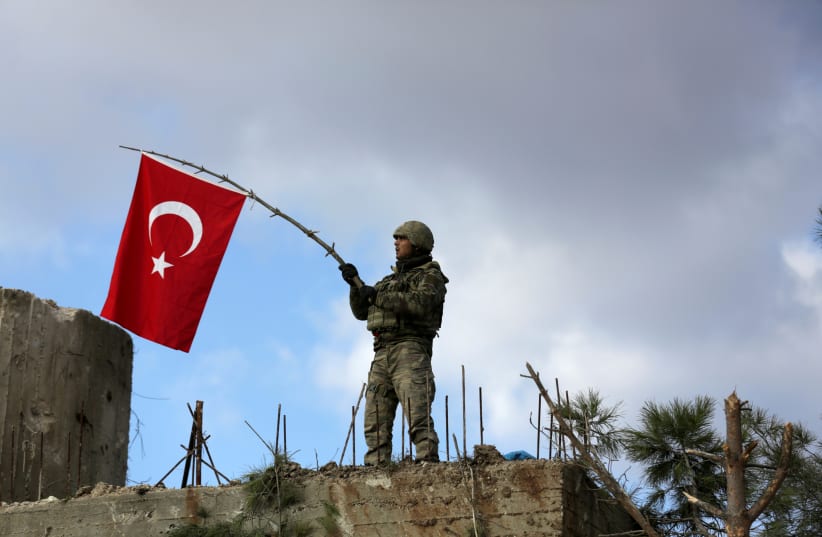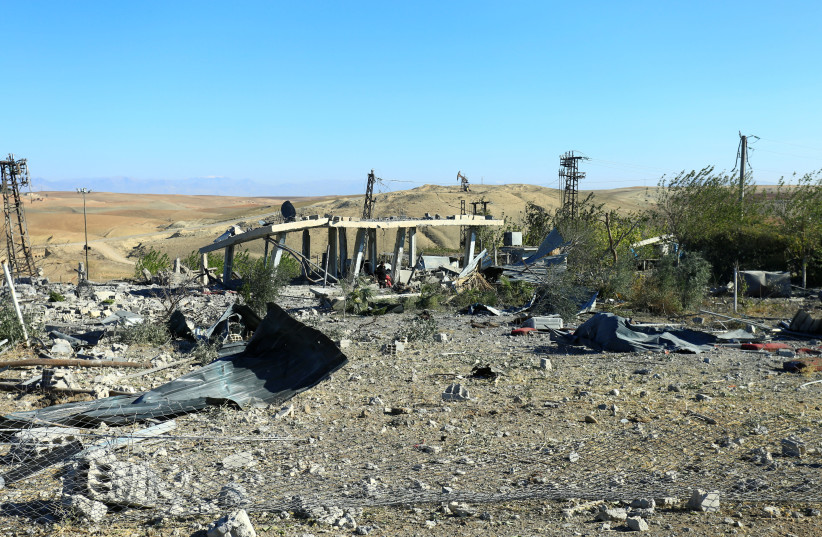Last month, Turkey claimed that a bombing in Istanbul gave it the right to carry out a massive campaign of airstrikes across eastern and northern Syria, targeting mostly Kurdish areas.
For years, Ankara has threatened to expand its invasion of eastern Syria and ethnically cleanse more areas of Kurds and other minorities along the border. This puts millions of people’s lives in constant limbo. Many of them survived the war on ISIS, only to face continued threats to their day-to-day life.
Today, the situation in eastern Syria remains unclear. The US-backed Syrian Democratic Forces, formed in 2015, is the main group that helped defeat ISIS. In general, the SDF was based on Kurdish fighters, as well as Arabs, Christians and other groups.
Eastern Syria has many minorities, including a historic Christian community and Yazidis. The People’s Defense Units, or YPG, formed one of the key Kurdish groups that fought ISIS. However, Turkey accused it of being a “terrorist” group – even though it has never engaged in any terror attacks. Turkey used this as an excuse to attack the YPG, first in 2016 near Manbij and later in Afrin in 2018.
This created a complex puzzle in eastern Syria. Basically, the beleaguered country is still divided and the remnants of the Syrian Civil War still dominate the landscape. The Syrian regime returned to control most of the cities in western Syria, such as Dara’a, Damascus, Homs, Hama and Aleppo.
An extremist group with links to al-Qaeda called Hay’at Tahrir al-Sham (HTS, or the Organization for the Liberation of the Levant) has come to control Idlib province. Idlib is also where many Syrians who fear the regime have fled, creating a combustible mix where refugees are under the control of extremists, who discriminate against women and minorities. The longer they are in charge, the more they teach hatred.
But for victims of the regime, there are no easy options because it is a vicious one that has killed hundreds of thousands of people in the war.
The Syrian rebel groups, which once contested cities throughout Syria, are now a proxy of Turkey and most of the original rebels are gone, either surrendering or leaving. Turkey’s goal after 2015 was to redirect the rebels to fight the Kurds, hoping to neutralize both groups.
For Ankara, the goal was to get the rebels to remove Kurds from areas like Afrin and along a “buffer zone” along the border, so it could expel some three million Syrians to these areas and “resettle” these Syrian refugees in formerly Kurdish areas. This was a cynical approach of Ankara – to use poor Arab Syrians who had fled to fight against poor Syrian Kurds, essentially destroying both groups.
THE US also has a role in Syria. Although former president Donald Trump – who had key advisers who were close to Ankara’s ruling AKP Party – sought to withdraw from Syria in 2018 and 2019, the US has remained. The architect of American backing of the SDF, Brett McGurk, is a key figure in the current Biden administration. But all this may not matter that much because the US role in eastern Syria is very small, only consisting of a force of hundreds backing up some 80,000 SDF fighters.
In the recent round of Turkish airstrikes, the US was unable to prevent those targeting areas where it is working with the SDF. This essentially means that Russia and the Syrian regime control the skies along the border and enable Turkey to operate warplanes and drones there to attack Kurds.
The right to strike
This Turkish “right” to bomb the border is a remnant of an old deal called the Adana Agreement of 1998 that allowed Turkey to enter Syria to pursue “terrorists” linked to the Kurdistan Workers Party. Although this eroded Syria’s sovereignty, the regime agreed because it was afraid of a Turkish invasion.
The 1990s were a different time. Then, the PKK was waging a war against Turkey, which was run by a nationalist secular party and was a NATO member and ally. Today’s Ankara regime is run by a right-wing Islamist party that is close to Hamas and often opposed to NATO. Turkey works closely with Russia and has oriented itself towards Central Asia and more “Islamic” causes. It often threatens Greece, for instance.
In the Syrian civil war, Ankara has sought to reimpose its control over Syrian territory, much as it has also done in northern Iraq. Because it poses as an ally of NATO, it also demands more F-16s for its air raids – even though it is targeting US partners in Syria. This creates a kind of impossible challenge that harms the local people of Syria the most.
For high-level US policymakers, Ankara casts a kind of spell, because it claims to be an ally that can help NATO regarding Russia. For instance, Turkey sold drones to Ukraine – which appear to no longer be useful – but Ankara then brokered a grain deal so it could play a role between Moscow and Kyiv.
Similarly, Ankara works with Moscow in Syria, which puts Russia in the strange position of needing Turkey’s backing regarding Ukraine issues and thus wants to avoid a conflict with Turkey in Syria.
BRIEFLY, the Kurds and other minorities in Syria get bombed so that Russia, Turkey and the US can do high-level deals. Ankara has hinted it may be willing to work with the Syrian regime. Russia also wants the regime to return more robustly to areas along the border, such as the Kurdish cities of Kobane, Qamishli and others. This means Turkey and Russia share interests: They both want the Syrian regime on the border.
The even-more complex problem
For the US in Syria, the problem is even more complex. Washington wants to stay in eastern Syria under the guise of fighting ISIS. The US has no real larger goal of stabilizing Syria or helping the civilians there achieve much more security assistance. That means no institution building.
Turkey has close ties with the Kurdistan Regional Government of northern Iraq, which allows it to cut off most trade that the SDF and civilian leadership of eastern Syria might engage in. This means that the leadership in eastern Syria, called The Autonomous Administration of North and East Syria (AANES), has to work via the Syrian regime.
Even large organizations like the UN work via Damascus, meaning that even though the US is in eastern Syria, it can’t help the SDF much beyond training and small arms. Whenever Turkey wants to bomb the power grid or cut off the water – as it has done recently – it can do so without any repercussions.
One could argue that this is what happens when the US has no doctrine in a place like Syria – when America sees its role as purely a military “by, with and through” approach. The US doesn’t do “nation-building” anymore, so the Kurds and others are mostly on their own.
So long as they are useful as a partner force against ISIS, they will be supported. The SDF, for instance, is asked to secure thousands of ISIS detainees and their families. Some of these ISIS member families are at a sprawling camp called Al-Hol. But this creates a Catch-22: The longer the SDF controls Al-Hol, the more the misery of the people there is blamed on the SDF. And the more SDF families grow up together, the more they radicalized.
At the same time, the US has left the “buffer zone” area along the border, turning it over to the SDF, Russians and Syrian regime in 2019. That means the SDF, whose original members were primarily Kurds, are doing most of their partnership work with Washington in areas that have a large Arab population, such as along the Euphrates, in Raqqa and in areas al-Shadadi in Hasakah governs.
The end result isn’t ideal because the SDF and its American partners end up with a kind of rump autonomous area centered on Hasakah, while the Kurdish areas the SDF was formed from are actually threatened daily by Turkish bombing and are run by the Russians and the Syrian regime.
FROM SOME cynical US policymakers’ perspectives, there are diminishing returns here. Many of them are convinced that Turkey is a necessary, if imperfect, ally – and that Kurds in Syria don’t deserve much of anything, despite having fought ISIS for almost a decade. One might think that being a US partner force, which the SDF has been since 2015, would mean there would be something in return. “Help fight ISIS and we will help provide security so your families can go to school in peace,” for example.
Instead, there is no real return. Although the SDF sacrificed thousands of lives fighting ISIS, today their families live in daily fear of being forced from their homes and there is no protection for them. This is hard to understand because Iran’s proxies get Iranian backing and Turkey’s proxies get Turkish backing, but US partner forces don’t seem to get much at all.
There are voices in Congress and others who want more to be done for the SDF and to provide more protections. However, since the US already left the border area in 2019, nothing stands between Turkey and another invasion than Russia and the Syrian regime – neither of which care about civilian lives.
Temporary, transactional and tactical
US officials have seen the work with the SDF as temporary, transactional and tactical. This means it’s mostly just a military relationship. America says it doesn’t deal with non-state actors, which means that the SDF or AANES will never get any real support but will rather be used in the anti-ISIS war.
For average people living in Qamishli, Hasakah or other areas, the future looks bleak. They will either be ethnically cleansed by another Turkish invasion, or have to live with the Russian-backed Syrian regime. This is an odd place for them to be, having fought ISIS and having tried to create a multi-ethnic state that was more representative than the Syrian regime, Ankara’s proxies or HTS.
The impossible challenge now facing the SDF and minorities such as Kurds, Christians, Yazidis and others in eastern Syria, is how they can overcome this challenge. The SDF leadership has asked the US not to enable another Turkish invasion. They suspended anti-ISIS operations when NATO member Turkey bombed them. But Ankara has shown that it is always willing to threaten an invasion and continue the chaos along the border.
Some argue that because there are elections coming up in Turkey, that there will be an invasion before the elections. In that bizarre sense, the people of eastern and northern Syria have to see their homes bombed every time there are Turkish elections. That’s not how democracy was supposed to work – or how the defensive alliance NATO was originally envisioned – but it’s what seems to be happening in Syria today.

